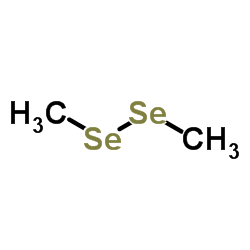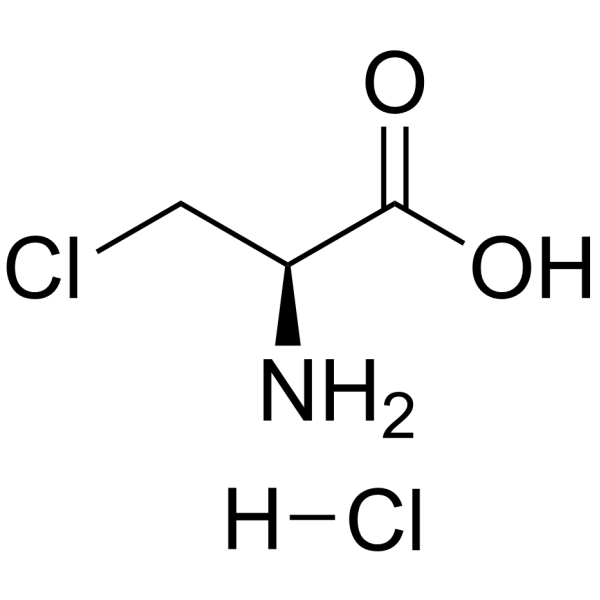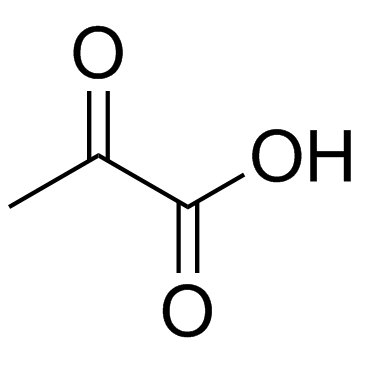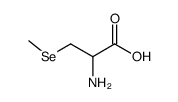26046-90-2
| Name | (2R)-2-amino-3-methylselanylpropanoic acid |
|---|---|
| Synonyms |
Selenium-methylselenocystine
L-Alanine, 3-(methylseleno)- 3-(Methylselanyl)-L-alanine Methylselenocysteine Se-Methylseleno-L-Cysteine Se-Methyl-seleno-L-cysteine L-Se-methylselenocysteine 3-(Methylseleno)-L-alanine Se-methylselenocysteine Se-methyl selenocystein (R)-2-Amino-3-(methylselanyl)propanoic acid Se-Methyl-L-selenocysteine MFCD00800565 |
| Description | Se-Methylselenocysteine, a precursor of Methylselenol, has potent cancer chemopreventive activity and anti-oxidant activity. Se-Methylselenocysteine is orally bioavailable, and induces apoptosis[1][2]. |
|---|---|
| Related Catalog | |
| In Vitro | Se-Methylselenocysteine (100-400 μM; 3 days) induces apoptosis in SKOV-33 cells[1]. Se-Methylselenocysteine (100-400 μM; 3 days) induces caspase-3 mediated apoptosis[1]. Apoptosis Analysis[1] Cell Line: SKOV-3 cells Concentration: 100, 200, 400 μM Incubation Time: 3 days Result: Resulted in a markedly increased accumulation of Sub-G1 phase, which occurred in both SeMSC concentration and culture time-dependent. Western Blot Analysis[1] Cell Line: SKOV-3 cells Concentration: 100, 200, 400 μM Incubation Time: 3 days Result: Resulted in a decrease in the expression of the 32 kDa form of procaspase-3. |
| In Vivo | Se-Methylselenocysteine (0.2 mg/mouse; p.o.; daily for 14 days) potentiates the antitumour activity of CDDP and Cyclophosphamide in nude mice bearing human FaDu and A253 head and neck xenografts[2]. Alzheimer's disease (AD) mice are treats with Se-Methylselenocysteine (0.75 mg/kg BW per day) in their drinking water for 10 months. Se-Methylselenocysteine reduces oxidative stress and neuro-inflammation; Se-Methylselenocysteine modulates the distribution and levels of several metal ions; Se-Methylselenocysteine decreases amyloid-β peptide (Aβ) generation by inhibiting the expression of its precursor protein APP and β-secretase (BACE1), and attenuates tau hyperphosphorylation and neurofibrillary tangles (NFT) formation via promoting protein phosphatase 2A (PP2A) activity, thereby preserving synaptic proteins and neuron activities and finally improving spatial learning and memory deficits in AD model mice[3]. Animal Model: Female athymic nude mice (bearing human A253 and FaDu squamous cell carcinoma xenografts)[2] Dosage: 0.2 mg/mouse Administration: p.o.; daily for 14 days (7 days before and 7 days after Cyclophosphamide or CDDP in a total of 14 days) Result: |
| References |
| Boiling Point | 314.1±37.0 °C at 760 mmHg |
|---|---|
| Melting Point | 177 °C(dec.) |
| Molecular Formula | C4H9NO2Se |
| Molecular Weight | 182.080 |
| Flash Point | 143.7±26.5 °C |
| Exact Mass | 182.979858 |
| PSA | 63.32000 |
| LogP | -0.89 |
| Vapour Pressure | 0.0±1.4 mmHg at 25°C |
| Storage condition | −20°C |
Synonym:2-Amino-3-Methylselanyl Propionic Acid; 3-(Methylseleno)-L-Alanine Section 2 - COMPOSITION, INFORMATION ON INGREDIENTS
Risk Phrases: 23/25 33 Section 3 - HAZARDS IDENTIFICATION EMERGENCY OVERVIEW
Toxic by inhalation and if swallowed. Danger of cumulative effects.The toxicological properties of this material have not been fully investigated. Potential Health Effects Eye: May cause eye irritation. Skin: May cause skin irritation. Ingestion: May cause irritation of the digestive tract. The toxicological properties of this substance have not been fully investigated. Inhalation: May cause respiratory tract irritation. The toxicological properties of this substance have not been fully investigated. Chronic: Effects may be delayed. Section 4 - FIRST AID MEASURES Eyes: Flush eyes with plenty of water for at least 15 minutes, occasionally lifting the upper and lower eyelids. Get medical aid. Skin: Get medical aid. Flush skin with plenty of water for at least 15 minutes while removing contaminated clothing and shoes. Wash clothing before reuse. Ingestion: Never give anything by mouth to an unconscious person. Get medical aid. Get medical aid immediately. Do NOT induce vomiting. If conscious and alert, rinse mouth and drink 2-4 cupfuls of milk or water. Inhalation: Remove from exposure and move to fresh air immediately. If not breathing, give artificial respiration. If breathing is difficult, give oxygen. Get medical aid. Notes to Physician: Treat symptomatically and supportively. Section 5 - FIRE FIGHTING MEASURES General Information: As in any fire, wear a self-contained breathing apparatus in pressure-demand, MSHA/NIOSH (approved or equivalent), and full protective gear. During a fire, irritating and highly toxic gases may be generated by thermal decomposition or combustion. Containers may explode when heated. Non-combustible, substance itself does not burn but may decompose upon heating to produce irritating, corrosive and/or toxic fumes. Runoff from fire control or dilution water may cause pollution. Extinguishing Media: Use water spray to cool fire-exposed containers. Do NOT get water inside containers. For small fires, use dry chemical, carbon dioxide, or water spray. For large fires, use water spray, fog or regular foam. Section 6 - ACCIDENTAL RELEASE MEASURES General Information: Use proper personal protective equipment as indicated in Section 8. Spills/Leaks: Vacuum or sweep up material and place into a suitable disposal container. Clean up spills immediately, observing precautions in the Protective Equipment section. Avoid generating dusty conditions. Provide ventilation. Section 7 - HANDLING and STORAGE Handling: Wash thoroughly after handling. Use only in a well-ventilated area. Minimize dust generation and accumulation. Do not breathe dust, vapor, mist, or gas. Do not get in eyes, on skin, or on clothing. Keep container tightly closed. Do not ingest or inhale. Use only in a chemical fume hood. Discard contaminated shoes. Storage: Store in a tightly closed container. Store in a cool, dry, well-ventilated area away from incompatible substances. Section 8 - EXPOSURE CONTROLS, PERSONAL PROTECTION Engineering Controls: Facilities storing or utilizing this material should be equipped with an eyewash facility and a safety shower. Use adequate ventilation to keep airborne concentrations low. Exposure Limits CAS# 26046-90-2: Personal Protective Equipment Eyes: Wear appropriate protective eyeglasses or chemical safety goggles as described by OSHA's eye and face protection regulations in 29 CFR 1910.133 or European Standard EN166. Skin: Wear appropriate protective gloves to prevent skin exposure. Clothing: Wear appropriate protective clothing to prevent skin exposure. Respirators: Follow the OSHA respirator regulations found in 29 CFR 1910.134 or European Standard EN 149. Use a NIOSH/MSHA or European Standard EN 149 approved respirator if exposure limits are exceeded or if irritation or other symptoms are experienced. Section 9 - PHYSICAL AND CHEMICAL PROPERTIES Physical State: Solid Color: white Odor: Not available. pH: Not available. Vapor Pressure: Not available. Viscosity: Not available. Boiling Point: Not available. Freezing/Melting Point: Not available. Autoignition Temperature: Not applicable. Flash Point: Not applicable. Explosion Limits, lower: Not available. Explosion Limits, upper: Not available. Decomposition Temperature: Solubility in water: Specific Gravity/Density: Not available. Molecular Formula: C4H9NO2Se Molecular Weight: 182.0285 Section 10 - STABILITY AND REACTIVITY Chemical Stability: Stable at room temperature in closed containers under normal storage and handling conditions. Conditions to Avoid: Incompatible materials, dust generation, excess heat, strong oxidants. Incompatibilities with Other Materials: Oxidizing agents. Hazardous Decomposition Products: Carbon monoxide, oxides of nitrogen, irritating and toxic fumes and gases, carbon dioxide, selenium/selenium oxides. Hazardous Polymerization: Has not been reported Section 11 - TOXICOLOGICAL INFORMATION RTECS#: CAS# 26046-90-2 unlisted. LD50/LC50: Not available. Carcinogenicity: SE-Methylseleno-L-Cysteine - Not listed by ACGIH, IARC, or NTP. Section 12 - ECOLOGICAL INFORMATION Section 13 - DISPOSAL CONSIDERATIONS Dispose of in a manner consistent with federal, state, and local regulations. Section 14 - TRANSPORT INFORMATION IATA Shipping Name: SELENIUM COMPOUND, N.O.S. Hazard Class: 6.1 UN Number: 3283 Packing Group: III IMO Shipping Name: SELENIUM COMPOUND, N.O.S. Hazard Class: 6.1 UN Number: 3283 Packing Group: III RID/ADR Shipping Name: SELENIUM COMPOUND, N.O.S. Hazard Class: 6.1 UN Number: 3283 Packing group: III Section 15 - REGULATORY INFORMATION European/International Regulations European Labeling in Accordance with EC Directives Hazard Symbols: T Risk Phrases: R 23/25 Toxic by inhalation and if swallowed. R 33 Danger of cumulative effects. Safety Phrases: S 20/21 When using do not eat, drink or smoke. S 28A After contact with skin, wash immediately with plenty of water. S 37 Wear suitable gloves. S 45 In case of accident or if you feel unwell, seek medical advice immediately (show the label where possible). WGK (Water Danger/Protection) CAS# 26046-90-2: No information available. Canada None of the chemicals in this product are listed on the DSL/NDSL list. CAS# 26046-90-2 is not listed on Canada's Ingredient Disclosure List. US FEDERAL TSCA CAS# 26046-90-2 is not listed on the TSCA inventory. It is for research and development use only. SECTION 16 - ADDITIONAL INFORMATION N/A |
| Hazard Codes | T: Toxic;N: Dangerous for the environment; |
|---|---|
| Risk Phrases | R23/25;R33;R50/53 |
| Safety Phrases | S20/21-S28-S45-S60-S61 |
| RIDADR | UN 3283 |
| WGK Germany | 3 |
| HS Code | 2922499990 |
|
~% 
26046-90-2 |
| Literature: Sami Labs Limited Patent: US6794537 B1, 2004 ; Location in patent: Page column 5-6 ; |
|
~% 
26046-90-2 |
| Literature: Sami Labs Limited Patent: US6794537 B1, 2004 ; Location in patent: Page column 5 ; |
|
~% 
26046-90-2 |
| Literature: Andreadou; Menge; Commandeur; Worthington; Vermeulen Journal of Medicinal Chemistry, 1996 , vol. 39, # 10 p. 2040 - 2046 |
| Precursor 5 | |
|---|---|
| DownStream 2 | |
| HS Code | 2922499990 |
|---|---|
| Summary | HS:2922499990 other amino-acids, other than those containing more than one kind of oxygen function, and their esters; salts thereof VAT:17.0% Tax rebate rate:9.0% Supervision conditions:AB(certificate of inspection for goods inward,certificate of inspection for goods outward) MFN tariff:6.5% General tariff:30.0% |






